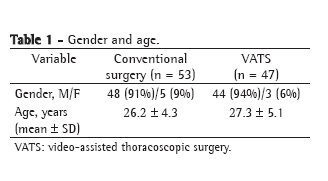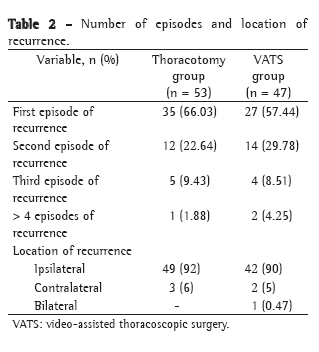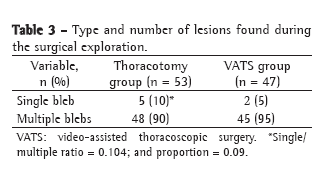



Agnaldo José Lopes, Roberto Mogami, Domenico Capone, Bernardo Tessarollo, Pedro Lopes de Melo, José Manoel Jansen
ABSTRACT
Objective: To correlate tomographic findings with pulmonary function findings, as well as to compare chest X-ray findings with high-resolution computed tomography (HRCT) findings, in patients with silicosis. Methods: A cross-sectional study was conducted in 44 non-smoking patients without a history of tuberculosis. Chest X-ray findings were classified according to the International Labour Organization recommendations. Using a semiquantitative system, the following HRCT findings were measured: the full extent of pulmonary involvement; parenchymal opacities; and emphysema. Spirometry and forced oscillation were performed. Pulmonary volumes were evaluated using the helium dilution method, and diffusing capacity of the lung for carbon monoxide was assessed. Results: Of the 44 patients studied, 41 were male. The mean age was 48.4 years. There were 4 patients who were classified as category 0 based on X-ray findings and as category 1 based on HRCT findings. Using HRCT scans, we identified progressive massive fibrosis in 33 patients, compared with only 23 patients when X-rays were used. Opacity score was found to correlate most closely with airflow, DLCO and compliance. Emphysema score correlated inversely with volume, DLCO and airflow. In this sample of patients presenting a predominance of large opacities (75% of the individuals), the deterioration of pulmonary function was associated with the extent of structural changes. Conclusions: In the early detection of silicosis and the identification of progressive massive fibrosis, HRCT scans are superior to X-rays.
Keywords: Silicosis; Occupational diseases; Tomography, x-ray computed; Respiratory function tests.
RESUMO
Objetivo: Correlacionar os parâmetros tomográficos com os de função pulmonar em portadores de silicose, bem como comparar os resultados da tomografia computadorizada de alta resolução (TCAR) com os da radiografia de tórax. Métodos: Foi realizado um estudo de corte transversal, em que foram avaliados 44 pacientes não-tabagistas e sem história pregressa de tuberculose. As radiografias foram classificadas de acordo com a proposta da Organização Internacional do Trabalho. Utilizando um sistema de escore semiquantitativo, os seguintes achados na TCAR foram quantificados: extensão total do envolvimento pulmonar, opacidades parenquimatosas e enfisema. Foram realizados espirometria, oscilações forçadas, avaliação dos volumes pulmonares pela técnica de diluição com hélio e medida da diffusing capacity of the lung for carbon monoxide (DLCO, capacidade de difusão do monóxido de carbono). Resultados: Dos 44 pacientes estudados, 41 eram homens, com média de idade de 48,4 anos. Na análise comparativa, 4 pacientes classificados na categoria 0 pela radiografia foram reclassificados na categoria 1 pela TCAR e, enquanto a radiografia diagnosticou 23 casos de fibrose maciça progressiva, a TCAR estabeleceu esse diagnóstico em 33 doentes. Para o escore de opacidades, as maiores correlações foram observadas com as medidas de fluxo, DLCO e complacência. Já o enfisema correlacionou-se negativamente com as medidas de volume, DLCO e fluxo. Nesta amostra com predomínio de grandes opacidades (75% dos indivíduos), a deterioração da função pulmonar associou-se com a extensão das alterações estruturais. Conclusões: Na silicose, a TCAR é superior à radiografia tanto na detecção precoce da doença quanto na identificação de fibrose maciça progressiva.
Palavras-chave: Silicose; Doenças ocupacionais; Tomografia computadorizada por raios X; Testes de função respiratória.
Introduction



